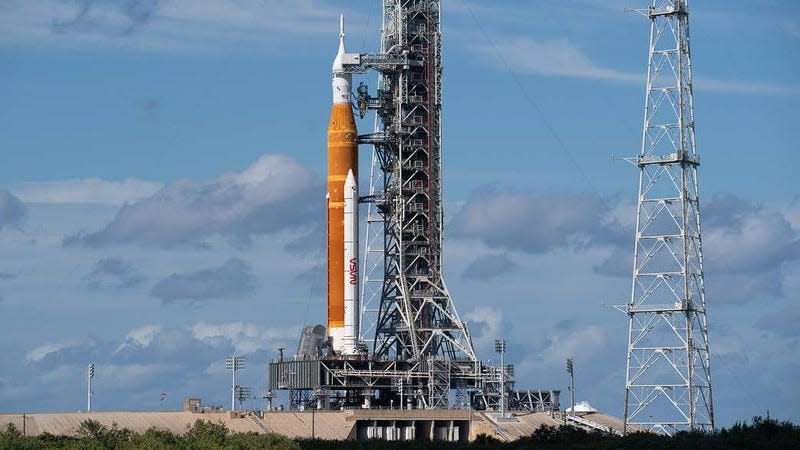NASA Makes Progress on SLS Launch Pad Repairs and Upgrades Ahead of Artemis 2 Launch

Launch pad 39B at NASA’s Kennedy Space Center is being prepped for the first crewed mission to the Moon in more than 50 years, with repairs underway to fix the damage caused by the inaugural flight of the space agency’s lunar program.
Engineers with NASA’s Exploration Ground Systems Program are completing a set of upgrades to mobile launcher 1 and launch pad 39B in anticipation of the upcoming Artemis 2 mission, which is set to launch in late 2024, according to NASA. The space agency is also working to fix the elevators on the mobile launcher, which sustained damage during the launch of Artemis 1.
Read more
NASA’s Space Launch System (SLS) rocket lifted off on November 16, 2022, sending an uncrewed Orion capsule on a 25.5-day journey to the Moon and back. The launch of the Artemis program’s first mission went smoothly, save for some damage to the mobile launcher caused by the massive rocket’s powerful blast.
Following the SLS launch, journalists were not allowed to take photos of Launch Complex 39B as NASA tried to keep the damage under wraps. The space agency later revealed that the launch tower suffered some scorch marks, a number of pad cameras got burned, and some nitrogen and helium supply lines were slightly damaged following the launch.
As the space agency prepares to send a crew on board the Orion capsule for Artemis 2, its engineers are hard at work to ensure the launch pad is good to go. Teams of technicians have repaired the elevators on the mobile launcher, which were the most impacted by the SLS launch blast. They are also “evaluating ways to harden the elevators and strengthen blast doors,” according to NASA.
In anticipation of the rocket’s next launch, NASA teams are refurbishing the blast plates that surround mobile launcher 1's flame hole, protecting it against the exhaust plume produced by the rocket’s engines, the space agency wrote, in addition to “modifying the panels on the flame deflector to account for turbulent exhaust flows.”
NASA now has to account for the four-person Artemis 2 crew. One of the major additions to the launch pad is an emergency life safety system, which provides the astronauts and the close-out crew with the ability to safely exit the mobile launcher in case of an emergency. The crew will be directed towards emergency egress baskets, which are suspended from a catenary system similar to the cars that hang off of ski lifts and travel down to emergency transportation vehicles at the base of the launch pad, according to NASA.
The emergency baskets will be installed on the mobile launcher later this year ahead of planned tests. Engineering teams are also testing a crew access arm— the point of entry and exit for the Artemis 2 crew to access the Orion capsule.
NASA is also finishing up the construction of an additional 1.4-million-gallon liquid hydrogen sphere that will be used to load propellant for the rocket. The launch pad is already equipped with one sphere, but the space agency now wants to have two spheres to reduce the time it takes to prepare for another launch attempt.
Artemis teams are also completing the installation of the environmental control system at the pad, which provides air supply, thermal control, and pressurization to the SLS rocket and Orion spacecraft.
The mobile launcher is expected to arrive at the launch pad later this summer as NASA prepares to conduct integrated ground system tests at Launch Complex 39B. “After the mobile launcher arrives at the launch pad, ground systems teams at Kennedy and the Artemis II crew will conduct a day of launch dry run, including operations for the crew, closeout crew, and the pad rescue team,” NASA wrote.
As part of the test, the four astronauts will don their orange spacesuits inside the crew quarters before heading towards the launch pad in the all-electric crew transportation vehicles.
The Artemis 2 crew is set to go on a trip around the Moon and back. Although this crew will not land on the lunar surface, the four astronauts will instead travel to the far side of the Moon at a distance of about 230,000 miles (370,150 kilometers) away from Earth.
Want to know more about humanity’s next giant leap in space? Check out our full coverage of NASA’s Artemis Moon program, the new Space Launch System (SLS) rocket and Orion spacecraft, the recently concluded Artemis 1 mission around the Moon, the four-person Artemis 2 crew, NASA and Axiom’s Artemis Moon suit, and the upcoming lunar Gateway space station. And for more spaceflight in your life, follow us on Twitter and bookmark Gizmodo’s dedicated Spaceflight page.
More from Gizmodo
Sign up for Gizmodo's Newsletter. For the latest news, Facebook, Twitter and Instagram.

